Table of Contents
If you're a proud owner of a luxurious leather sofa, you know the importance of keeping it clean and well-maintained. Regular cleaning not only enhances the appearance of your sofa but also prolongs its lifespan.
Find out what tools and materials you need for this task and the best type of cleaner and cloth for leather. In this article, we will provide you with a step-by-step guide on cleaning your leather sofa, along with tips on maintenance and things to avoid. Let's get started!
Explore further: How To Clean Dusty Leather Couch
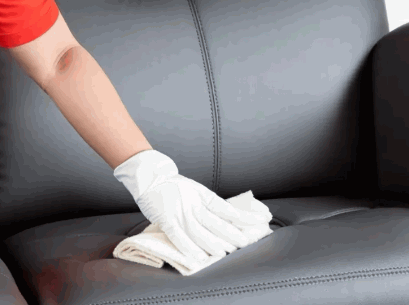
Cleaning your leather sofa is crucial to maintain its appearance, durability, and longevity. Regular cleaning helps remove dirt, stains, and debris that can accumulate over time, preserving the quality and aesthetic appeal of your sofa.
Plus enhancing the visual appeal, proper cleaning also plays a significant role in preventing stains and damage caused by spills or everyday use. By incorporating a regular cleaning routine, you can maintain the sofa's condition and prevent any build-up that could potentially harm the leather over time.
Maintaining a clean sofa can extend its lifespan and ensure that it remains a centerpiece of your living space for years to come. Neglecting regular cleaning may lead to premature wearing of the leather, resulting in costly repairs or even the need for a replacement.
Regarding cleaning leather sofas, it's essential to utilize products specifically designed for leather care. Avoid harsh chemicals that could damage the material and opt for gentle cleaners that effectively remove dirt without compromising the integrity of the leather.
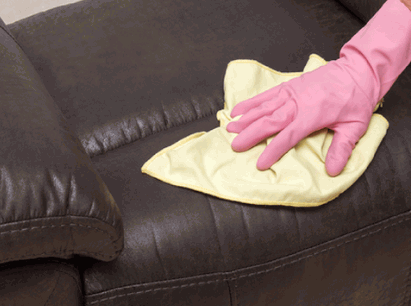
Regular cleaning of your leather sofa offers numerous benefits, including maintaining its visual appeal, preventing stains and discoloration, and ensuring the longevity of the material. Consistent cleaning helps preserve the leather's natural oils, preventing drying and cracking over time.
By regularly cleaning your leather sofa, you not only enhance its aesthetic charm but also safeguard it against common issues such as stains, discoloration, and premature aging.
Proper care ensures that the leather remains soft and supple, extending its lifespan significantly. Taking the time to clean your sofa regularly can prevent dirt and grime from settling in, which can lead to damages that are more challenging to repair. By maintaining a cleaning routine, you contribute to the overall health and appearance of your beloved leather furniture.

To effectively clean a leather sofa, you will need specific tools and materials. These include a gentle leather cleaner, a soft cloth or sponge, water, a leather conditioner, and a dry cloth for buffing. White vinegar and mild soap can be used for tougher stains or deep cleaning purposes.
Plus these essentials, having a soft-bristled brush can help remove dust and dirt from crevices without damaging the leather surface. Microfiber cloths are also handy for gentle cleaning and drying, as they are soft and absorbent. Cotton swabs or cotton balls can target small areas or seams where dirt accumulates.
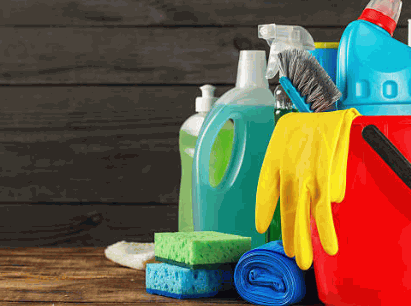
When choosing a cleaner for your leather sofa, opt for a product specifically designed for leather care. Look for gentle cleaners that do not contain harsh chemicals or abrasives, as these can damage the leather's surface. Castile soap or a commercial leather cleaner are excellent choices for regular maintenance and mild cleaning needs.
Castile soap, known for its natural and mild properties, is a great option for those looking for a gentle yet effective cleaning solution. It is particularly suitable for light soil or routine cleaning tasks, providing a safe and nourishing cleanse for your beloved leather sofa.
On the other hand, commercial leather cleaners often come with targeted formulas that address specific issues such as stains, spills, or deep-seated dirt. These products are engineered to protect the leather's finish while also restoring its natural luster, making them ideal for more intensive cleaning sessions.
When cleaning a leather sofa, it is essential to use a soft, lint-free cloth or sponge. Microfiber cloths are ideal for gently wiping down the surface without causing damage or scratches. Avoid rough or abrasive materials that can scratch the leather and compromise its texture and appearance.
Microfiber cloths not only provide effective cleaning but also help in maintaining the natural shine and suppleness of the leather. Their ultra-fine fibers are gentle on the surface, making them suitable for regular cleaning routines. The structure of microfiber helps to trap dirt and dust particles, ensuring a thorough cleaning process. This material is also highly absorbent, allowing it to pick up spills and stains efficiently without leaving any residue behind.
While basic tools like a cleaner and cloth are essential for cleaning a leather sofa, some special equipment can enhance the process. Consider using a leather conditioner to moisturize and protect the leather, a soft brush for gentle scrubbing, and rubbing alcohol for tough stains or marks.
Having a specific leather cleaning brush can help target dirt in the seams and crevices without damaging the material. A lint-free microfiber cloth is ideal for applying cleaner and conditioner evenly across the surface without leaving behind any residue.
For deeper conditioning, investing in a specialized leather cream can provide added nourishment to keep the leather soft and supple. This can help prevent cracking and maintain the sofa's luxurious appearance over time.
Cleaning a leather sofa involves several steps to ensure thorough maintenance and care for the material. This step-by-step guide will walk you through the process of preparing the sofa, removing surface dirt, applying the cleaner, wiping down and drying the sofa, and finally conditioning the leather to restore its natural luster and protect it from damage.
Begin by preparing your cleaning area and gathering the necessary supplies, including a mild leather cleaner, distilled water, soft cloths, and a leather conditioner. It's important to conduct a spot test on a hidden area of the sofa to ensure the cleaner is safe for use.
After cleaning, use a dry cloth to wipe off any excess moisture and allow the sofa to air dry completely before applying a quality leather conditioner. Apply the conditioner in a thin, even layer using a clean cloth, following the product instructions for best results. Let the conditioner penetrate the leather to keep it supple and prevent cracking.
Begin the leather sofa cleaning process by preparing the surface. Remove any cushions or objects from the sofa, and gently dust off or vacuum the crevices and seams to eliminate loose debris. This initial step sets the foundation for a thorough and effective cleaning routine.
Once the surface is cleared of any potential hindrances, it is essential to wipe it down with a soft, dry cloth to further eliminate any remaining dust or particles. Prepping the leather sofa in this manner ensures that the cleaning agents can work efficiently without encountering any obstructions.
Be sure to check for any stains or spills that may require specific treatment before proceeding with the overall cleaning process. Addressing these areas preemptively can prevent them from spreading or becoming more stubborn to remove during the cleaning phase.
By investing time in properly preparing your leather sofa, you are setting the stage for a successful and rejuvenating cleaning session that will help preserve the longevity and beauty of your furniture.
To clean a leather sofa effectively, start by removing surface dirt and dust. Use a soft cloth or vacuum with a brush attachment to gently wipe or vacuum the entire surface of the sofa. Pay attention to seams and crevices where dirt tends to accumulate, ensuring a thorough cleaning process.
It's crucial to remove the surface dirt and dust before proceeding with any deep cleaning methods to prevent scratching or embedding debris into the leather.
When using a soft cloth, make sure it's clean and free from any abrasive materials that could damage the delicate leather finish.
Alternatively, if using a vacuum, attach a soft brush nozzle to prevent any accidental scratches while effectively removing dirt particles.
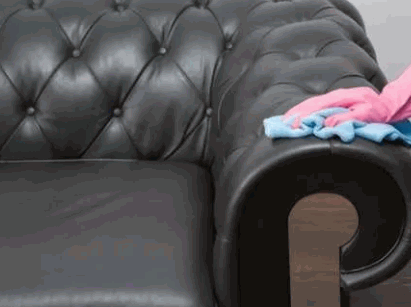
Once the surface is free of dirt and dust, apply a small amount of the chosen leather cleaner onto a clean, soft cloth or sponge. Gently rub the cleaner onto the leather in circular motions, working in small sections to ensure even application and effective cleaning. Avoid oversaturating the leather with the cleaner.
It is crucial to remember that using too much cleaner can harm the leather, as excess moisture may lead to discoloration or damage. By controlling the amount applied and employing gentle pressure, you can maintain the leather's integrity while effectively removing dirt and grime from its surface.
Ensure that the cleaner is specifically formulated for leather to prevent any adverse reactions. Checking the product label for compatibility with your sofa's leather type is advisable before proceeding with the application.
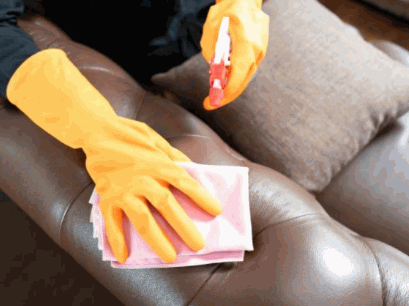
After applying the cleaner, use a clean, dry cloth to wipe down the leather sofa surface. Ensure thorough removal of any excess cleaner residue and moisture to prevent water spots or staining. Allow the sofa to air dry naturally or use a fan on a low setting to speed up the drying process.
Properly wiping down and drying your leather sofa post-cleaning is crucial in maintaining its longevity and appearance. The removal of residual cleaner is essential to prevent any damage that could occur from prolonged exposure.
To avoid water spots, it's important to ensure the sofa is completely dry. Utilizing fans can help expedite the process, especially in humid environments.
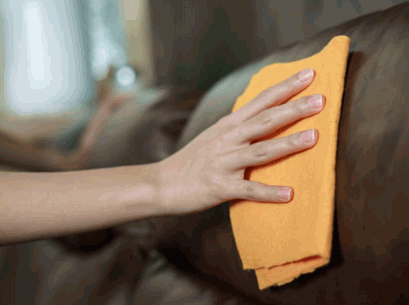
To maintain the leather's suppleness and protect it from drying out, apply a high-quality leather conditioner to the sofa. Using a soft cloth, gently rub the conditioner into the leather in a circular motion, ensuring even coverage. Allow the conditioner to be absorbed by the leather for the recommended duration before buffing to restore its natural sheen.
Conditioning your leather sofa is crucial for its longevity as it helps retain the natural oils that keep the leather soft and supple. By applying a leather conditioner regularly, you not only prevent drying and cracking but also improve the overall appearance of the sofa.
Remember, the key to successful conditioning lies in the technique. The gentle rubbing motion ensures that the conditioner penetrates deep into the leather, nourishing it from within. This process not only moisturizes the leather but also forms a protective barrier against dirt and stains.
The benefits of conditioning go beyond just aesthetics; it plays a significant role in maintaining the leather's integrity, increasing its resistance to wear and tear. As a vital part of your leather maintenance routine, conditioning should not be overlooked for optimal protection and care of your beloved sofa.
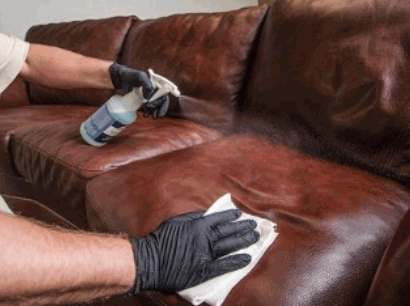
To ensure your leather sofa stays clean and well-maintained, consider implementing a few helpful tips. Avoid direct sunlight exposure to prevent fading and drying of the leather. Regularly dust the sofa with a soft cloth to prevent dirt buildup, and address spills or stains promptly to prevent them from setting into the leather.
It is beneficial to use a leather conditioner or protectant periodically to keep the leather supple and moisturized. When cleaning, always follow the manufacturer's guidelines and use products specifically designed for leather upholstery.
Consider placing the sofa away from windows or using curtains to reduce direct sunlight exposure. Cover the sofa when not in use to prevent dust accumulation. In case of spills, blot gently with a clean cloth and avoid rubbing to prevent spreading.
By incorporating these simple practices into your routine, you can enjoy a clean and well-preserved leather sofa for years to come.
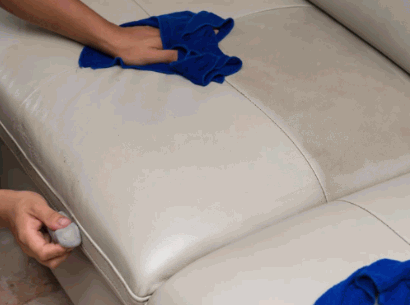
While cleaning your leather sofa, it is essential to be mindful of certain practices to avoid damaging the material. Avoid using harsh chemicals, abrasive cleaners, or excessive water, as these can strip the leather of its natural oils and lead to drying or cracking. Steer clear of sharp objects that can scratch or puncture the leather surface.
Instead, opt for mild, pH-balanced leather cleaners specifically designed for leather upholstery. These cleaners help preserve the leather's natural oils and prevent it from drying out. When dealing with stains, gently dab the affected area with a damp cloth rather than rubbing vigorously, which can damage the leather fibers.
Remember to regularly condition your leather sofa to keep it supple and prevent it from becoming brittle. Choose a high-quality leather conditioner and apply it in gentle, circular motions to ensure even coverage.
When cleaning a leather sofa, avoid using products like bleach, ammonia, or household cleaners that are not designed for leather care. These harsh chemicals can damage the leather's surface, leading to discoloration, dryness, or cracking. Abrasive tools or sharp objects should be avoided to prevent scratches or tears.
It's essential to choose cleaning agents specifically formulated for leather, such as leather cleaners or saddle soap, which help maintain the material's natural oils and prevent drying out. Using a microfiber cloth or soft brush for gentle cleaning can effectively remove dust and dirt without causing harm. Regular conditioning with a leather conditioner is also crucial to keep the leather hydrated and supple, preventing it from becoming brittle over time.
Certain cleaning techniques should be avoided when cleaning a leather sofa to prevent damage or deterioration. Do not scrub vigorously or use excessive force, as this can scratch or wear out the leather. Similarly, avoid soaking the leather with water or cleaning solutions, as this can penetrate the material and lead to discoloration or warping.
Instead, opt for gentle cleaning methods that involve lightly dabbing the leather with a soft cloth dampened with a mild soap solution. Avoid harsh chemicals or abrasive cleaners, as these can strip the natural oils from the leather, causing it to dry out and crack over time. Regularly conditioning the leather with a suitable leather conditioner can help maintain its softness and resilience. Remember to test any cleaning agent on a hidden spot of the sofa before applying it to the entire surface to ensure compatibility with the leather.